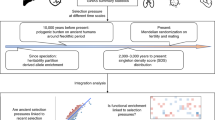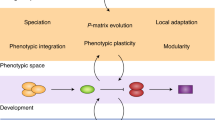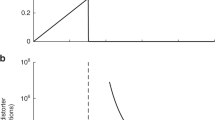Abstract
There is a growing interest in evolutionary models of human adiposity. Frequent reference has been made to ‘thrifty genes’ or ‘thrifty phenotypes’, referring to a variety of metabolic or behavioural traits that in one or the other way imply frugality in the expenditure or storage of energy. However, there is confusion over how the strategy of thrift has been incorporated into human biology. At the broadest level, humans represent a thrifty species relative to other mammals, indicating that metabolic adaptations had a crucial role in the emergence of the Homo lineage, in particular in buffering reproduction from ecological stochasticity. In contemporary humans, some variability in adiposity may be attributable to genotypes systematically favoured in certain ecological settings. Genetic variability is also present within populations, and may be considered bet hedging (distributing risk across offspring to increase parental fitness). Bet hedging is an alternative to genetic drift for accounting for genetic variability in the absence of strong selective pressures. Contrasting with genetic variability emerging over the long-term, thrifty phenotypes represent a response to short-term ecological variability. Physiological plasticity allows the emergence of variability across the life course in response to ecological cues experienced directly or by very recent ancestors. Finally, cultural norms or individual preferences allow voluntary behavioural manipulation of thrift in individuals. Overall, there is a range of factors and processes both favouring and opposing thrifty genes, which may reflect moderate bet hedging rather than systematic adaptation. Plasticity protects the genome from selective pressures by tailoring the organism to ongoing ecological conditions. The fact that obesity can occur in different individuals through different genotypes, life histories and behaviours indicates that different treatments are also likely to be required.
This is a preview of subscription content, access via your institution
Access options
Subscribe to this journal
Receive 12 print issues and online access
$259.00 per year
only $21.58 per issue
Buy this article
- Purchase on Springer Link
- Instant access to full article PDF
Prices may be subject to local taxes which are calculated during checkout
Similar content being viewed by others
References
Speakman JR . A nonadaptive scenario explaining the genetic predisposition to obesity: the ‘predation release’ hypothesis. Cell Metab 2007; 6: 5–12.
Speakman JR . Thrifty genes for obesity, an attractive but flawed idea, and an alternative perspective: the ‘drifty gene’ hypothesis. Int J Obes (Lond) 2008; 32: 1611–1617.
Prentice AM, Rayco-Solon P, Moore SE . Insights from the developing world: thrifty genotypes and thrifty phenotypes. Proc Nutr Soc 2005; 64: 153–161.
Prentice AM, Hennig BJ, Fulford AJ . Evolutionary origins of the obesity epidemic: natural selection of thrifty genes or genetic drift following predation release? Int J Obes (Lond) 2008; 32: 1607–1610.
Neel JV . Diabetes mellitus: a ‘thrifty’ genotype rendered detrimental by ‘progress’? Am J Hum Genet 1962; 14: 353–362.
Cranford J . Ecological strategies of a small hibernator, the western jumping mouse Zapus princeps. Can J Zool 1983; 61: 232–240.
Dausmann KH, Glos J, Ganzhorn JU, Heldmaier G . Physiology: hibernation in a tropical primate. Nature 2004; 429: 825–826.
Dark J . Annual lipid cycles in hibernators: integration of physiology and behaviour. Ann Rev Nutr 2005; 25: 469–497.
Pond CM . Physiological and ecological importance of energy storage in the evolution of lactation: evidence for a common pattern of anatomical organisation of adipose tissue in mammals. Symp Zool Soc Lond 1984; 51: 1–32.
Hargrove JL . Adipose energy stores, physical work, and the metabolic syndrome: lessons from hummingbirds. Nutr J 2005; 4: 36.
Pond CM . The Fats of Life. Cambridge University Press: Cambridge, 1998.
Wade GN, Schneider JE . Metabolic fuels and reproduction in female mammals. Neurosci Biobehav Rev 1992; 16: 235–272.
Wells JC . Is obesity really due to high energy intake or low energy expenditure? Int J Obes Relat Metab Disord 1998; 22: 1139–1140.
Bouchard C . The biological predisposition to obesity: beyond the thrifty genotype scenario. Int J Obes (Lond) 2007; 31: 1337–1339.
O’Rahilly S, Farooqi IS . Human obesity as a heritable disorder of the central control of energy balance. Int J Obes (Lond) 2008; 32: S55–S61.
Cann RL, Stoneking M, Wilson AC . Mitochondrial-Dna and human-evolution. Nature 1987; 325: 31–36.
Harpending H, Rogers A . Genetic perspectives on human origins and differentiation. Annu Rev Genomics Hum Genet 2000; 1: 361–385.
Kivisild T, Reidla M, Metspalu E, Parik J, Geberhiwot T, Usanga E et al. Eastern African origin of the human maternal lineage cluster, ancestral to people outside Africa. Am J Hum Genet 2001; 69: 1386.
Garrigan D, Hammer MF . Reconstructing human origins in the genomic era. Nat Rev Genet 2006; 7: 669–680.
Wells JC . The evolution of human fatness and susceptibility to obesity: an ethological approach. Biol Rev Camb Philos Soc 2006; 81: 183–205.
Wells JC . Sexual dimorphism of body composition. Best Pract Res Clin Endocrinol Metab 2007; 21: 415–430.
Kuzawa CW . Adipose tissue in human infancy and childhood: an evolutionary perspective. Am J Phys Anthropol 1998; 177–209.
Wells JC, Treleaven P, Cole TJ . BMI compared with 3-dimensional body shape: the UK National Sizing Survey. Am J Clin Nutr 2007; 85: 419–425.
Wells JC, Stock JT . The biology of the colonizing ape. Am J Phys Anthropol 2007; 191–222.
Wells JCK . The Evolutionary Biology of Human Body Fat: Thrift and Control. Cambridge University Press: Cambridge, 2010.
Foley RA . The influence of seasonality on human evolution. In: Ulijaszek SJ, Strickland SS (eds). Seasonality and Human Ecology. Cambridge University Press: Cambridge, 1993. pp 17–37.
Knott CD . Changes in orangutan caloric intake, energy balance, and ketones in response to fluctuating fruit availability. Int J Primatol 1998; 19: 1061–1079.
Stearns SC . The Evolution of Life Histories. Oxford University Press: Oxford, 1992.
Chakravarthy MV, Booth FW . Eating, exercise, and ‘thrifty’ genotypes: connecting the dots toward an evolutionary understanding of modern chronic diseases. J Appl Physiol 2004; 96: 3–10.
McMichael AJ . Diabetes, ancestral diets and dairy foods. In: Macbeth H, Sheety P (eds). Health and Ethnicity. Taylor and Francis: London, 2001. pp 133–146.
Foley R . The evolutionary consequences of increased carnivory in humans. In: Stanford CB, Bunn HT (eds). Meat-Eating and Human Evolution. Oxford University Press: Oxford, 2001. pp 305–331.
Foley RA, Lee PC . Ecology and energetics of encephalisation in hominid evolution. Philos Trans R Soc B 1991; 334: 223–232.
Gurven M, Walker R . Energetic demand of multiple dependents and the evolution of slow human growth. Proc Biol Sci 2006; 273: 835–841.
Leonard WR, Robertson ML . Evolutionary perspectives on human nutrition: the influence of brain and body size on diet and metabolism. Am J Hum Biol 1994; 6: 77–88.
Aiello LC, Wheeler P . The expensive-tissue hypothesis—the brain and the digestive-system in human and primate evolution. Curr Anthropol 1995; 36: 199–221.
Cohen MN, Armelagos GJ . Palaeopathology and the Origins of Agriculture. Academic Press: Orlando, Florida, 1984.
Benyshek DC, Watson JT . Exploring the thrifty genotype's food-shortage assumptions: a cross-cultural comparison of ethnographic accounts of food security among foraging and agricultural societies. Am J Phys Anthropol 2006; 131: 120–126.
Diamond J . Guns, Germs and Steel. Vintage: London, 1998.
Wells JC . Ethnic variability in adiposity and cardiovascular risk: the variable disease selection hypothesis. Int J Epidemiol 2008; 38: 63–71.
Hancock AM, Witonsky DB, Gordon AS, Eshel G, Pritchard JK, Coop G et al. Adaptations to climate in candidate genes for common metabolic disorders. PLoS Genet 2008; 4: e32.
Kagawa Y, Yanagisawa Y, Hasegawa K, Suzuki H, Yasuda K, Kudo H et al. Single nucleotide polymorphisms of thrifty genes for energy metabolism: evolutionary origins and prospects for intervention to prevent obesity-related diseases. Biochem Biophys Res Commun 2002; 295: 207–222.
Sorensen TI, Price RA, Stunkard AJ, Schulsinger F . Genetics of obesity in adult adoptees and their biological siblings. BMJ 1989; 298: 87–90.
Stunkard AJ, Harris JR, Pedersen NL, McClearn GE . The body-mass index of twins who have been reared apart. N Engl J Med 1990; 322: 1483–1487.
Dina C, Meyre D, Gallina S, Durand E, Körner A, Jacobson P et al. Variation in FTO contributes to childhood obesity and severe adult obesity. Nat Genet 2007; 39: 724–726.
Loos RJ, Lindgren CM, Li S, Wheeler E, Zhao JH, Prokopenko I et al. Common variants near MC4R are associated with fat mass, weight and risk of obesity. Nat Genet 2008; 40: 768–775.
Willer CJ, Speliotes EK, Loos RJ, Li S, Lindgren CM, Heid IM et al. Six new loci associated with body mass index highlight a neuronal influence on body weight regulation. Nat Genet 2009; 41: 25–34.
Wells JC . Parent-offspring conflict theory, signaling of need, and weight gain in early life. Q Rev Biol 2003; 78: 169–202.
Philipi T, Seger JH . Hedging evolutionary bets, revisited. Trends Ecol Evol 1989; 4: 41–44.
Wright S . The roles of mutation, inbreeding, crossbreeding and selection in evolution. Proc Sixth Int Congr Genet 1932; 1: 356–366.
Wells JC, Chomtho S, Fewtrell MS . Programming of body composition by early growth and nutrition. Proc Nutr Soc 2007; 66: 423–434.
Barker M, Robinson S, Osmond C, Barker DJ . Birth weight and body fat distribution in adolescent girls. Arch Dis Child 1997; 77: 381–383.
Malina RM, Katzmarzyk PT, Beunen G . Birth weight and its relationship to size attained and relative fat distribution at 7 to 12 years of age. Obes Res 1996; 4: 385–390.
Law CM, Barker DJ, Osmond C, Fall CH, Simmonds SJ . Early growth and abdominal fatness in adult life. J Epidemiol Community Health 1992; 46: 184–186.
Wells JC . The thrifty phenotype as an adaptive maternal effect. Biol Rev Camb Philos Soc 2007; 82: 143–172.
Ong KK, Ahmed ML, Emmett PM, Preece MA, Dunger DB . Association between postnatal catch-up growth and obesity in childhood: prospective cohort study. BMJ 2000; 320: 967–971.
Fewtrell MS, Lucas A, Cole TJ, Wells JC . Prematurity and reduced body fatness at 8–12 y of age. Am J Clin Nutr 2004; 80: 436–440.
Leary SD, Smith GD, Rogers IS, Reilly JJ, Wells JC, Ness AR . Smoking during pregnancy and offspring fat and lean mass in childhood. Obesity (Silver Spring) 2006; 14: 2284–2293.
Durnin JV . Energy requirements of pregnancy: an integration of the longitudinal data from the five-country study. Lancet 1987; 2: 1131–1133.
Hales CN, Barker DJ . Type 2 (non-insulin-dependent) diabetes mellitus: the thrifty phenotype hypothesis. Diabetologia 1992; 35: 595–601.
Gluckman PD, Hanson MA, Spencer HG . Predictive adaptive responses and human evolution. Trends Ecol Evol 2005; 20: 527–533.
Wells JC . Environmental quality, developmental plasticity and the thrifty phenotype: a review of evolutionary models. Evol Bioinform Online 2007; 3: 109–120.
Wells JC . Flaws in the theory of predictive adaptive responses. Trends Endocrinol Metab 2007; 18: 331–337.
Ong KK, Northstone K, Wells JC, Rubin C, Ness AR, Golding J et al. Earlier mother's age at menarche predicts rapid infancy growth and childhood obesity. PLoS Med 2007; 4: e132.
Slobodkin LB, Rapoport A . An optimal strategy of evolution. Q Rev Biol 1974; 49: 181–200.
Pigliucci M . Do we need an extended evolutionary synthesis? Evolution 2007; 61: 2743–2749.
Nelson LD, Morrison EL . The symptoms of resource scarcity: judgments of food and finances influence preferences for potential partners. Psychol Sci 2005; 16: 167–173.
Maynard LM, Serdula MK, Galuska DA, Gillespie C, Mokdad AH . Secular trends in desired weight of adults. Int J Obes (Lond) 2006; 30: 1375–1381.
Pasquet P, Brigant L, Froment A, Koppert GA, Bard D, de Garine I et al. Massive overfeeding and energy balance in men: the Guru Walla model. Am J Clin Nutr 1992; 56: 483–490.
Tovee MJ, Swami V, Furnham A, Mangalparsad R . Changing percpetions of attractiveness as observers are exposed to a different culture. Evol Hum Behav 2006; 27: 443–456.
Ridley M . The Red Queen: Sex and the Evolution of Human Nature. Penguin: London, 1993.
Brown PJ, Konner M . An anthropological perspective on obesity. Ann NY Acad Sci 1987; 499: 29–46.
Fidler N, Sauerwald T, Pohl A, Demmelmair H, Koletzko B . Docosahexaenoic acid transfer into human milk after dietary supplementation: a randomized clinical trial. J Lipid Res 2000; 41: 1376–1383.
DelPrado M, Villapando S, Lance A, Alfonso E, Demmelmar H, Koletzko B . Contribution of dietary and newly formed arachidonic acid to milk secretion in women in low fat diets. Adv Exp Med Biol 2000; 478: 407–408.
Tovee MJ, Hancock PJ, Mahmoodi S, Singleton BR, Cornelissen PL . Human female attractiveness: waveform analysis of body shape. Proc Biol Sci 2002; 269: 2205–2213.
Norgan NG . The beneficial effects of body fat and adipose tissue in humans. Int J Obes Relat Metab Disord 1997; 21: 738–746.
Acknowledgements
I very much appreciate the comments of two anonymous reviewers, and that of Dr Toomas Kivisild, University of Cambridge.
Author information
Authors and Affiliations
Corresponding author
Rights and permissions
About this article
Cite this article
Wells, J. Thrift: a guide to thrifty genes, thrifty phenotypes and thrifty norms. Int J Obes 33, 1331–1338 (2009). https://doi.org/10.1038/ijo.2009.175
Received:
Revised:
Accepted:
Published:
Issue Date:
DOI: https://doi.org/10.1038/ijo.2009.175
Keywords
This article is cited by
-
Diverse biological processes coordinate the transcriptional response to nutritional changes in a Drosophila melanogaster multiparent population
BMC Genomics (2020)
-
Vestigial Drifting Drives in Homo sapiens
Biological Theory (2018)
-
Low Birthweight Increases the Likelihood of Severe Steatosis in Pediatric Non-Alcoholic Fatty Liver Disease
American Journal of Gastroenterology (2017)
-
Obesity in International Migrant Populations
Current Obesity Reports (2017)



